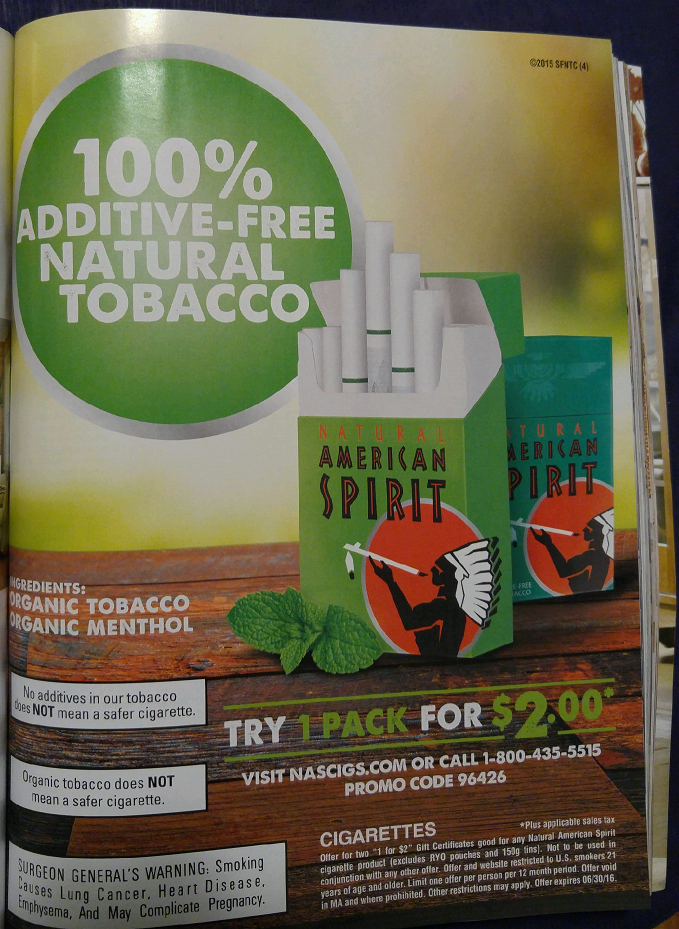Do you mind if I rant for a minute? I promise to make a point eventually.
Thanks.
Take a look at this full page ad from the October 2015 issue of Architectural Digest:
What do you notice?
1) Natural/Organic. The market for organic products is getting bigger and bigger. Now you even can buy 100% natural lung poison.
2) The feel of the ad itself. The visual elements have a light feeling. The fresh baby tobacco plant (which look strikingly similar to a sprig of mint), the rustic table the cigarettes are sitting on, the color palette and smooth sans serif typeface all gently whisper “clean,” “pure” and “natural.” Maybe even “wholesome.”
3) “Additive-free.” At first glance, you may think it says “Addictive-free.” That’s exactly how the first few people I showed this page to read that “headline.” Misleading, right?
4) Disclaimers that essentially destroy the story the rest of the ad is telling. “Additive-free” organic tobacco does NOT make a safer cigarettes.
5) Oh, and a strong front-end offer. A pack for $2 is a steal these days!
It’s crazy how much creative energy spent is spent fabricating a disingenuous marketing statement. If only these admakers were using their powers for good!
(Note: In August, the FDA began pursuing regulatory action against 3 cigarette manufacturers, including the one that makes Natural American Spirit brand, for these marketing tactics.)
Fighting the Tide
You’ve seen those “Real Cost” TV commercials, right?
Recent statistics show that ad campaigns like “The Real Cost” and “the Truth,” as well as other factors have decreased smoking to an all time low in the U.S. That’s the positive power of marketing at work.
(Interestingly, sales of Natural American Spirits have increased 86% since 2009, even as the tobacco industry is shrinking. The power of marketing at work.)
What you may not have seen are the warnings on cigarette boxes in Thailand. They’re a lot stronger than Surgeon General’s warnings. The images show the long-term effects of smoking RIGHT ON THE PACKAGING. You have to see it to believe it. Warning: these pictures are very unsettling, so much so that I’m not going to put them here. If you’d like to see some examples, click here or just Google “Thai cigarette warnings.”
Don’t say I didn’t warn you.
Scary stuff. But they’re are honest and realistic. What’s really scary is that something like 40% of the men in Thailand still smoke.
What Gives?
Everyone knows smoking is bad for their health. And that truth is increasingly “in their face.” So why doesn’t EVERYONE quit?
That’s an important question to ask because these are the forces you have to face as a business owner/service provider trying to persuade people to buy from you.
Normalcy bias – If it hasn’t happened yet, people often don’t believe it will ever happen. “It” can be anything. Our brains are designed that way. It’s good for maintaining our sanity, but it makes changing customer buying behavior more difficult.
If you rely on fear-based marketing or sale messages, you need to be aware of this bias.
Force of habit – Most of the decisions we make on a day-to-day basis are habitual. Our buying behavior is very much impacted by force of habit. Convincing people to change their routine, or even getting them to realize they’re not consciously thinking about that routine, is no easy task. Even if it’s bad for them.
You really have 3 choices: attach yourself to your potential customer’s already-established habit, come up with a way to make him turn off autopilot and choose you (a really good front-end offer can be a great way to do that) or approach him where he hasn’t developed a habit.
Social proof and peer approval – People care what other people think about them. How are you using that to your advantage?
Contrary/competitive messaging – You need to say something uniquely valuable, and you need to say if often enough to grab some real estate in your prospect’s mind.
Plain old disbelief – According the Mark Schenk “if you assert something as a fact – even if it is a fact – less than half of the people listening will believe you.” (Mark gives his remedy for that reality in this article.)
What’s the point I’m getting at? It’s this: Marketing can be powerful. Use it responsibly and honestly.
I know, this is all pretty surfacey.
But hey, what did you expect from a rant?

